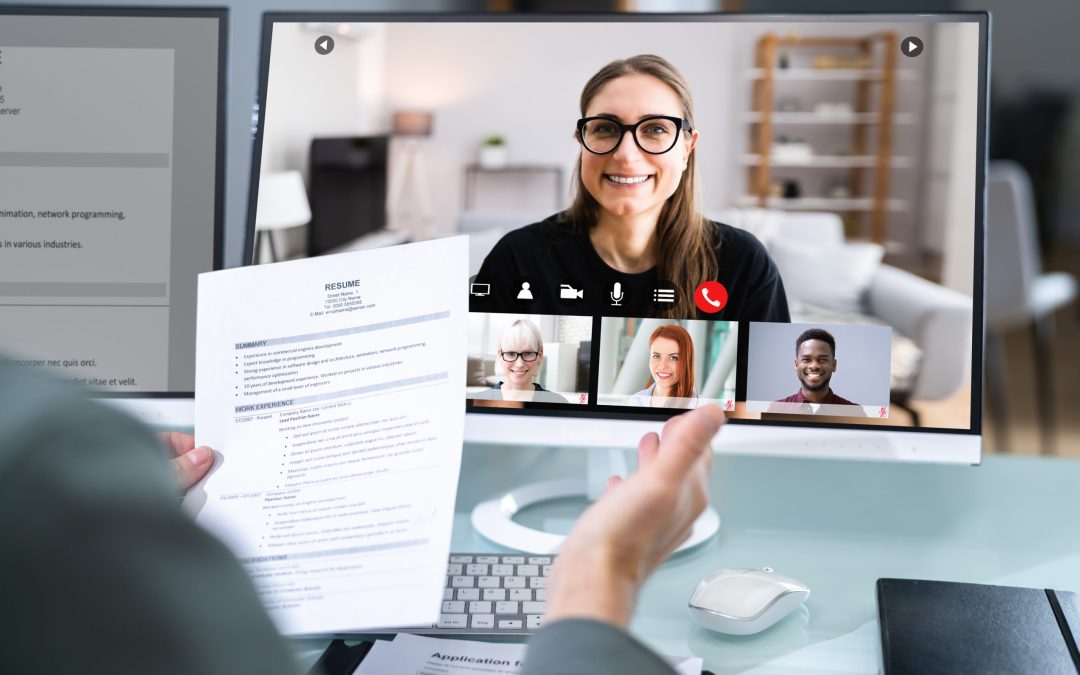For many companies, video interviewing is an essential part of their recruiting process, not just because working remotely has become the “new norm” but for its many time- and cost-saving advantages. Does that put the traditional recruiter-led interview in jeopardy of becoming extinct?
Video Interviewing Is Here To Stay
Video interviewing has too many advantages to be ignored, and technology gets more advanced each year, allowing for more sophisticated and detailed intelligence to be gleaned from an applicant’s performance. Plus, integrating a virtual interviewing solution into the standard recruitment process has never been easier.
Utilizing one-way, or asynchronous, video interviews provide faster measuring of a candidate’s potential without a great deal of work by the recruiter in the screening stage of the application process. Since the candidate is responding to preset questions, the recruiter or hiring manager can get a fair amount of the information needed to assess the individual’s fit for the role.
As it’s grown in popularity in recent years, more and more applicants see video interviewing as a standard part of the process. It allows them to showcase themselves and their talents beyond their résumé/CV, allowing hiring leaders to see more of who they are and gather valuable insights needed during the screening process.
Providing a smooth, flexible, and enjoyable candidate experience is increasingly important. Using one-way video interviewing can be less stressful, allowing the person to do it at a time that suits them and in the comfort of home. Plus, if applicants know the questions ahead of time, they can practice their responses, giving them more confidence when doing the actual recording. Practicing can eliminate the anxiety inherent in a job interview, which will help the recruiter and hiring manager assess candidates more effectively, as nervousness can negatively impact a candidate’s performance.
Face-to-Face Interviews Aren’t Going Anywhere
Whether meeting in person or via video conferencing, establishing that human connection provides much more than assessing the candidate’s job experience. The one-on-one interaction allows the recruiter or hiring manager a better sense of the applicant’s communication skills, personality, professionalism, how they react under pressure, and more. Conversely, it helps applicants gather the information they need to assess whether the company and the position are a fit for them.
While the traditional interview and video interview provides the opportunity to gather the same information about the applicant, such as observing body language, voice inflection, and mannerisms, the face-to-face interview allows a deeper dive into these elements. In addition, the natural flow of conversation provides greater insight into the candidate than what could be observed from a video interview.
Within the confines of face-to-face conversations, applicants may be more animated and spontaneous in their answers, thus giving more information about who they are and how they think. These “real” answers are more telling than the carefully worded ones given during a one-way video interview.
Combine Both for Maximum Efficiency
There’s no denying that technology and process streamlining are wonderful things. Still, there are parts to the application process that can’t–and shouldn’t–be replaced by technology or eliminated to save time. Advancements in efficiency don’t mean the “human” in “human resources” needs to be sacrificed.
Video interviews should be viewed as an enhancement to the recruiting process rather than a replacement.
The two interviewing methods can easily co-exist in a company’s hiring process. By utilizing video interviews in the preliminary hiring stage as a screening tool, recruiters can feel confident that only the more qualified applicants are invited for face-to-face or in-person interviews. In addition, since the applicants are responding to preset questions, the hiring team can be assured of getting a good portion of the information needed to assess the person’s fit for the role, making the traditional interview a better use of everyone’s time.
The ideal process is often tied to the type of hiring being done. For example, video interviewing is more beneficial for high-volume recruiting and entirely remote positions. But for executive and senior roles, the recruitment process may bypass the video interview entirely in favor of the face-to-face as these roles are a significant investment and need that personal engagement.
A face-to-face interview can be time-consuming due to the amount of preparation needed, the scheduling of multiple individuals, etc. However, more intelligent decision-making is possible by incorporating a video pre-screening process. Then that investment of time is well worth it because that’s time spent on a quality candidate.
Conclusion
Overall, HR leaders can make more informed decisions by combining the advantages of both video and in-person interviewing methods. Video interviews as the screening tool to narrow down the applicant pool, and then face-to-face to further evaluate the remaining qualified candidates to find the best fit.

